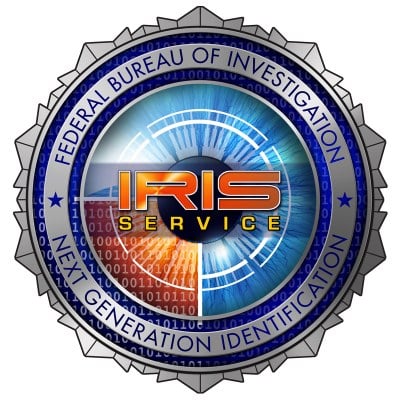Next Generation Identification (NGI) Iris Service
 The NGI Iris Service provides a fast, accurate, and contactless biometric identification option for law enforcement and criminal justice users. In just a few seconds, agencies can submit iris images to the NGI Iris Service. Standard iris cameras capture images using near-infrared light and are easily integrated into existing booking station software. The NGI Iris Service uses an iris image repository within the NGI System. All iris images enrolled in the repository are linked to a tenprint fingerprint record. The NGI Iris Service has an automated iris search that is used for identification. The Iris Image Identification Search (IIDS) returns a rap sheet, mug shot (if available), and National Crime Information Center (NCIC) data from the Wanted Persons, National Sex Offender Registry, and the Immigration Violator files.
The NGI Iris Service provides a fast, accurate, and contactless biometric identification option for law enforcement and criminal justice users. In just a few seconds, agencies can submit iris images to the NGI Iris Service. Standard iris cameras capture images using near-infrared light and are easily integrated into existing booking station software. The NGI Iris Service uses an iris image repository within the NGI System. All iris images enrolled in the repository are linked to a tenprint fingerprint record. The NGI Iris Service has an automated iris search that is used for identification. The Iris Image Identification Search (IIDS) returns a rap sheet, mug shot (if available), and National Crime Information Center (NCIC) data from the Wanted Persons, National Sex Offender Registry, and the Immigration Violator files.
Iris Recognition Overview
Iris recognition uses the features of the iris, the colored ring in the eye, to identify an individual. The iris is formed before birth and remains relatively stable throughout life. Irises are unique - even identical twins can be correctly identified with iris images.
- Fast - Typical FBI processing takes a few seconds (search & enroll).
- Accurate - Identification searches are fully automated and return a single-subject. The NGI Iris Service algorithm has a demonstrated accuracy rate exceeding 99 percent, equivalent to tenprint fingerprint identification.
- Easy - Iris capture is automatic, contactless, and fast.
- Contactless - Iris capture is between 12 and 36 inches.
Use Cases
Iris recognition is useful in scenarios requiring very fast, accurate identification. Criminal justice agencies sharing iris data from local, regional, state, tribal, and federal systems with the NGI Iris Service will increase iris recognition utility and may enable additional use cases.
Correctional Facilities
The NGI Iris Service has an automated iris search that is used for identification validation at participating correctional facilities. Typically, inmates have an image of their iris scanned during intake. When they are moved or released, staff can query the inmate's iris image to ensure they are moving or releasing the correct person. This technology may also be used in court proceedings and for probation/parole check-ins.
Correctional and booking facilities are ideal locations to enroll iris images during inmate processing or arrest booking procedures. Correctional facilities can use the identification service to identify inmates during movement and release. NCIC information provided with the search results can alert staff to outstanding wants/warrants. Additional match information including sex offender status, gang affiliation(s), and caution & medical codes enhances officer and inmate safety.
Supervised Release
The NGI Iris Service can be used to reduce administrative burden by providing a quick, contactless biometric identification with NCIC information including any wants/warrants. Iris recognition also provides opportunities for additional process automation which allows more attention on supervised individuals.
Mobile Identification
The rapid development of mobile iris-enabled devices provides a low-cost, efficient method to access the NGI Iris Service. Mobile iris identification can be used for roadside stops, probation/parole, sex offender check-ins, and other situations where travel to a law enforcement station is cost/time prohibitive.
Border Security
The NGI Iris Service is fast and iris images can be collected quickly with contactless cameras. Iris identification provides a faster way to screen subjects. Iris recognition also helps mitigate processing delays for individuals with damaged, worn, or mutilated fingerprints. Subjects identified as Immigration Violators can be denied entry or transferred to the Immigration and Customs Enforcement, Enforcement Removal Operations for detention and deportation.
Forensic Identification Cases
Unlike fingerprints, iris images are found in digital evidence. Numerous smart phones, devices, and laptop computers can be unlocked using the iris biometric. The iris images are stored on the device, not by the service provider. Iris images can be extracted and queried against the NGI Iris Service for identification purposes.
Resources
Best Practices
NISTIREXV - Includes a poster, slideshow, and document providing guidance for iris image collection.
Security Policy
Technical Standards
- FBI EBTS Information
- NIST Special Publication 500-290 Edition 3 (2015)
- Data Format for the Interchange of Fingerprint, Facial & Other Biometric Information ANSI/NIST-ITL 1-2011 Update: 2015
- Iris Cameras: Standards Relevant for Camera Selection-2018
Research Documentation
Contact Information
- 304-625-IRIS (4747)
- iris@fbi.gov

